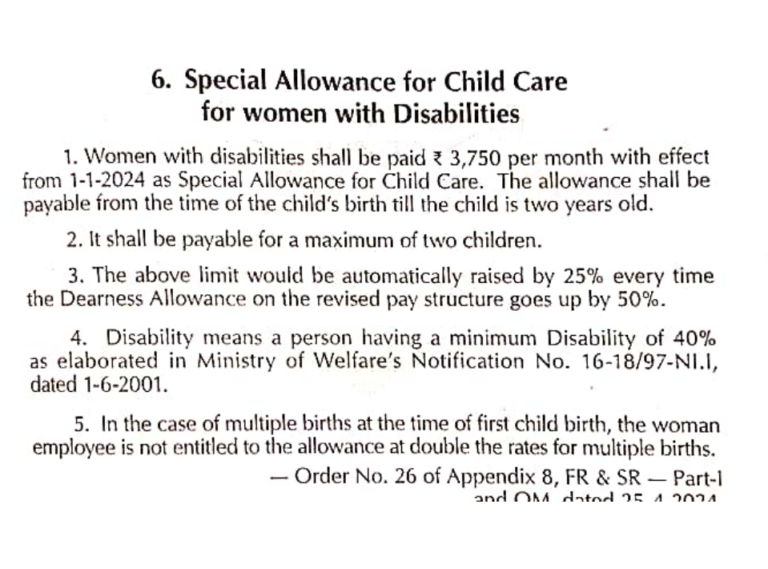
Special Allowance for Child Care for Women with Disabilities
Introduction
Being a mother is no small feat, and when you’re navigating that journey with a disability, the challenges can multiply. That’s why having supportive policies like the Special Allowance for Child Care for Women with Disabilities is crucial. This initiative isn’t just about financial help—it’s about recognizing the resilience and needs of women who raise children while living with physical, intellectual, or emotional disabilities.
Understanding the Special Allowance
So, what exactly is this allowance? Simply put, it’s a government-provided financial benefit aimed specifically at women with disabilities who have child care responsibilities. It’s designed to ease the burden of parenting by offering regular support that can be used for childcare, medical needs, or accessibility enhancements.
Purpose of the Allowance
This isn’t just about money—it’s about empowering women to parent with dignity and support. The allowance exists to bridge the gap that often exists between disability and parenting, giving women a stronger foundation to care for their children and themselves.
Eligibility Criteria
To qualify for this special allowance, a woman generally needs to:
Be a legal resident or citizen of the country offering the benefit
Have a certified disability (this can vary by country but usually includes medical certification)
Be responsible for the care of at least one child under a certain age (often 18)
Some programs may also assess the severity of disability or the income level of the applicant.
Types of Disabilities Covered
This program usually includes a wide range of disabilities:
Physical disabilities like paralysis, mobility impairments, or chronic health conditions
Intellectual and developmental disabilities such as Down syndrome or autism
Mental health-related conditions including severe depression, anxiety disorders, or PTSD
Child Care Responsibilities Explained
Not every form of child care qualifies—programs usually look for direct caregiving, which includes:
Feeding, bathing, and dressing the child
Helping with schoolwork or therapy
Attending medical appointments
Some may differentiate between full-time and part-time caregiving when deciding the allowance amount.
Allowance Benefits
Monthly Financial Support
The most obvious benefit is a monthly stipend, which can range from modest amounts to more substantial payments depending on the disability level and caregiving responsibility.

Additional Child Care Services
Many governments also provide access to:
Childcare centers with trained staff
Home visit programs
Respite care for mothers needing rest
Access to Health and Community Services
Beyond financial help, recipients often gain priority access to medical consultations, psychological support, and inclusive community programs.
How the Allowance Helps in Daily Life
This support can truly transform daily routines. For example:
Hiring help for physically demanding tasks like lifting or transportation
Making home modifications for better mobility and child safety
Paying for therapies such as speech or occupational therapy for the child
How to Apply
The application process varies, but here’s the usual flow:
Fill out a form—either online or at a local social service office.
Attach documents like a disability certificate, child’s birth certificate, and proof of residency.
Submit it to the appropriate welfare or child care department.
Common Mistakes to Avoid
Don’t let paperwork get in the way of benefits. Avoid these:
Forgetting to include all supporting documents
Leaving sections blank on the application
Not following up on the status after submission
Real-Life Stories
Meet Alisha, a mother with cerebral palsy. With the allowance, she was able to hire part-time help for school runs and use funds to adapt her home for better mobility. Or Fatima, who uses the monthly payment to cover her son’s therapy and school needs.
These are not just statistics—they’re lives changed through a bit of support and a lot of courage.
Government and NGO Support
Several programs amplify the impact of this allowance:
NGOs offer legal assistance, education, and advocacy.
Community centers provide inclusive playgroups and parenting classes.
Some governments even match funds or provide additional grants for multiple children.
Challenges Still Faced
Unfortunately, the road isn’t entirely smooth. Many women report:
Limited awareness about the allowance
Long approval times
Inconsistent support across regions
Policy Improvements Needed
To make the program more effective, experts suggest:
Streamlining application processes
Increasing outreach, especially in rural areas
Expanding definitions to include invisible disabilities
Conclusion
The Special Allowance for Child Care for Women with Disabilities is more than a policy—it’s a step toward a more inclusive, compassionate society. Supporting these mothers ensures not only their well-being but also that of the next generation. Let’s raise awareness, push for better access, and champion the rights of all mothers—regardless of ability.
FAQs
1. Is this allowance available in all countries?
No, it depends on local laws. Some countries offer robust support while others are still developing similar programs.
2. Can single mothers with disabilities apply?
Absolutely. In fact, single mothers are often prioritized due to increased caregiving responsibilities.
3. Is there an income limit to qualify?
Some programs have income caps, while others focus solely on disability and caregiving role.
4. How long does it take to receive the allowance after applying?
It can take anywhere from a few weeks to a couple of months, depending on processing speed and documentation.
5. Can the allowance be used for education-related expenses?
Yes! Many recipients use it to cover school fees, tutoring, or learning aids for their children.
Please don’t forget to leave a review.
The information provided on this blog is for general informational purposes only. All content is provided in good faith; however, we make no representation or warranty of any kind regarding the accuracy or completeness of any information.

Disclaimer:
This blog post is intended for informational purposes only. All rights, references, and credits related to official government service rules and guidelines belong to Swamy’s Publications, the authoritative source on these matters. We acknowledge and extend our courtesy to Swamy’s Publication for their valuable work in compiling and publishing official content. This blog does not claim ownership or authorship of any content originally published by Swamy’s Publications.
For more information and updates please follow the page and don’t forget to leave your comment.
